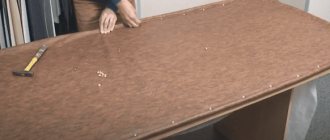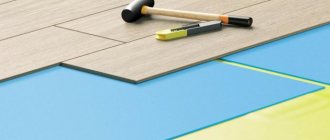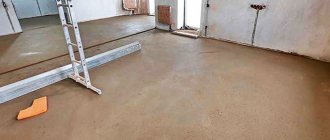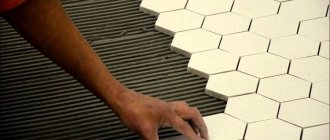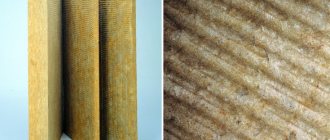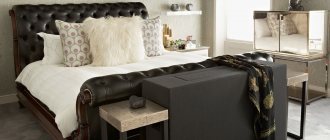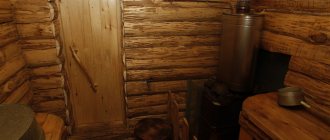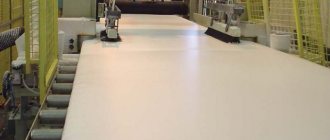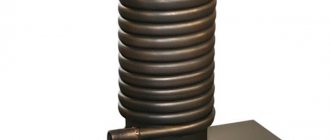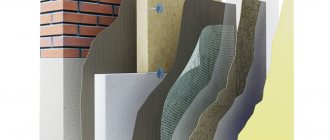One of the leading places on the building materials market belongs to the famous French brand Izover, under whose brand a whole series of insulation materials are produced for the thermal insulation of a house. The product has excellent performance characteristics, which were appreciated by consumers who used it to insulate their home. The material is excellent for internal and external thermal insulation of wooden buildings. Insulating a house with Izover is an excellent way to eliminate heat loss, prevent the entry of cold masses into the room, and increase the comfort of living. In the article we will look at the types and characteristics of heat insulation, and also focus on insulation methods.
Types of insulation materials
The manufacturer produces several product lines, among which there are universal insulation materials that are suitable for thermal insulation of the entire structure. There are also highly specialized materials designed to insulate one or another part of the house: internal and external walls, roofs, floors, baths.
Universal insulation
This group is divided into:
- "Optimal". The material is made of basalt fiber. It is designed for thermal insulation of all parts of a frame house, with the exception of the foundation. They can be used to insulate roofs, partitions, walls, and floors along joists. It has low thermal conductivity, is not flammable, and can be laid without additional fasteners.
- "Pro." The insulation is made of fiberglass mats. Can be used for thermal insulation both inside and outside log houses and frame structures. It has very low thermal conductivity. Safe and non-flammable insulation.
- "Classic". It is also based on fiberglass. It is produced in mats and slabs with a porous structure, due to which it has good thermal insulation characteristics. It is used for various structural elements of a house made of logs and beams, except for surfaces with high loads, including the foundation. It has low strength, so it cannot be used under screed and plaster.
- "Extra". Fiberglass slab insulation is characterized by increased strength and elasticity, resistance to compression. It has the lowest thermal conductivity compared to other materials from the manufacturer, due to which, when used, heat loss is minimal.
- "Warm house". This insulation is made from recycled fiberglass. It is suitable for thermal insulation of any parts of the structure. The material goes on sale in the form of slabs, which are convenient to use for vertical surfaces, and rolled mats used for insulating the floor between joists and interfloor ceilings.
Insulation materials for highly specialized work
Among the materials produced under the Izover brand, it is worth mentioning highly specialized mineral wool insulation materials, which are divided into various groups for individual areas of application:
- Facade insulation. This group of materials is intended for insulating facades under plaster using the wet method. The name of each insulation necessarily contains the word “facade”. They are sold in slabs and are made of basalt or fiberglass.
- Insulation for external and internal walls of a wooden house. This group includes materials that can be used for thermal insulation of suspended structures: under lining, siding, blockhouse and others. All of them are made of glass fiber in the form of slabs, less often in the form of mats.
- Thermal insulators for roofing. Materials for this purpose undergo additional processing to ensure increased moisture resistance. They are made from basalt and glass fibers in the form of slabs and mats.
- Materials for floor insulation. Products in this group are distinguished by increased strength and rigidity; they can withstand increased loads well. They are used for flooring with joists and floating floor structures.
- Insulation for baths and saunas. The main distinguishing characteristic from other groups is a two-layer composition, one layer is mineral wool, the second is a foil coating. The material simultaneously performs two functions - insulation and vapor barrier.
Pros and cons of the material
Despite the fact that each product has its own specifics, it is possible to identify common positive and negative aspects of all Izover brand insulation.
Advantages:
- low thermal conductivity;
- good sound absorption;
- high degree of vapor permeability;
- water resistance;
- non-flammability;
- light weight of slabs.
However, the material also has some disadvantages:
- Formaldehyde resins are used to bind the components, which calls into question the environmental friendliness of the insulation.
- During installation, small particles of material may enter the respiratory tract, so the use of protective equipment is mandatory.
- In direct contact with water, the insulation absorbs moisture, which requires good waterproofing, especially when laying the material on the facade and roof of a log house.
Insulation with polyurethane foam
Modern thermal insulation polyurethane foam is very well suited for insulating a wooden house from the inside, however, it requires compliance with certain requirements.
First of all, it is necessary to clean the walls from dust and sawdust, protect the floor, windows and doors with protective materials.
Next, carry out a series of works step by step:
- perform sheathing in 60 cm increments with 4x4 cm or 5x5 cm timber;
- spray polyurethane foam between the sheathing boards;
- wait up to 12 hours until the layer of material dries completely;
- level the excess material in accordance with the level of the sheathing.
Next, lay the layers of the wall pie in accordance with the installation technology.
Insulation using polyurethane foam
Thus, insulation inside can be done quite effectively. If you carry out all the stages of laying cake materials using proven technology, you can achieve a good result: the walls will retain heat well in the room and thereby create a favorable indoor microclimate on cold days.
Thermal insulation of log walls with Izover
- A wooden frame made of beams is mounted on the walls; the distance between the posts should be 10 mm less than the width of the insulation.
- Insulating material is laid in the gaps between the posts. It should fit very tightly, usually no additional fixation is required.
- A vapor barrier membrane is spread horizontally on top of the thermal insulation. The canvases are laid overlapping, and their joints are sealed with adhesive tape.
- A counter-lattice is mounted on the racks to create an air gap, and sheets of drywall, lining or other finishing material are fixed to it.
According to these instructions, walls are insulated both outside and inside a wooden house.
Insulation of walls inside and outside the house - differences
Wall insulation is carried out both inside and outside .
If it is necessary to insulate walls, then, as a rule, one insulation option is chosen: either from the inside of the load-bearing wall or from the outside.
It is also possible to insulate a wall on both sides, but this is not always necessary : insulation options are chosen based on climatic conditions, construction features, and individual preferences.
Indoor insulation is installed on the inside of the building.
The disadvantages of this option are the following:
- the free space of the room decreases;
- the likelihood of dew point formation inside the wall or between the insulation and the wall.
Internal insulation of the walls of a house is good because:
- weather conditions will not affect the work schedule;
- If the building has cladding, it is possible to preserve it unchanged.
IMPORTANT!
When installing internal insulation, it is necessary to install a reliable vapor barrier inside the building.
Insulation of external walls is carried out from the outside of the building. With this type of thermal insulation, the usable area of the structure is preserved; there is no need to install a vapor barrier layer . However, if the cladding of the building has already been completed, it must be dismantled.
External insulation
How to insulate a roof with your own hands
- Wooden posts are installed at a distance of 60 cm from each other.
- A windproof membrane is spread over the frame; it is necessary that it completely covers the inside of the roof and the wooden elements of the sheathing.
- The width of the insulation roll is 1220 mm; cutting it in half produces two strips of 610 mm each.
- The cut parts are installed between the bars; due to their size, they will fit snugly against the racks.
- The entire insulating structure is covered with a vapor barrier film.
- To create a ventilation gap, a counter-lattice is installed, which is then covered with a decorative coating.
Description
If you want to insulate your facade with Izover, you should know that this material is a unique solution. The main problem with using mineral wool may be the softness of the material and the tendency of the slabs to change their original linear dimensions. Here a reasonable conclusion arises that it is not advisable to thermally insulate external walls with such material, because it will still crumble over time.
However, the manufacturer solved this problem by developing a special technology. It provides for giving the slabs the necessary rigidity. As a result, it was possible to obtain a unique material, which is made on the basis of mineral wool. It can be used even without external cladding. The thermal conductivity coefficient in this case is not higher than 0.038 W/(m*K), but the expected service life is 25 years. There is nothing strange here, because the only problem with mineral wool is its tendency to wrinkle, which, by the way, was solved by making the material almost eternal.
The slabs do not change their linear dimensions with seasonal temperature fluctuations and humidity changes. Otherwise, such a solution would not be of value for façade insulation. Mineral wool has a certain vapor permeability, which allows for the implementation of a reasonable wall structure, where the resistance to moisture movement decreases as it migrates from the inner layers to the outer ones. In addition, “Isover” for the facade is not flammable, and its dimensions are very convenient for installation and are equal to 60 x 120 cm. As for the thickness, it ranges from 50 to 200 mm.
Recommendations for installing floors under screed
How to insulate a floor along joists with slab material is described in detail in the article “Advantages of Izolon for insulating a wooden floor.” Work with Izover is carried out in a similar way. Here we will describe the main points of wet insulation.
- The concrete base is covered with a waterproof film.
- A special damper tape is installed along the entire perimeter of the room; it should cover part of the floor and the wall, while its height should be 15 cm higher than the level of the screed.
- Insulation boards are laid.
- To protect the material from moisture penetration, another layer of waterproofing is laid on top of the thermal insulation; the sheets should overlap each other by about 20-25 cm.
- The cement screed is poured, after it has completely dried, the excess tape is cut off and the finishing floor covering is laid.
Insulation of walls from the inside in a private house using mineral wool
Before insulating the walls from the inside, it is necessary to secure the sheathing.
Mineral wool is a material that has good thermal insulation properties, is easy to install and durable.
It is necessary to lay mineral wool slabs between the sheathing boards in such a way that no gaps are formed.
Besides:
- mineral wool is secured with nails and dowels (fungi);
- lay the material from bottom to top;
- The edges of the mineral wool are slightly pressed for a tighter fit.
IMPORTANT!
Mineral wool should be laid in an even layer : without creases and waves; if the installation is multi-layered, the joints should not overlap or form cracks.
After the insulation is securely fastened, a vapor barrier layer is laid on it.
Insulation with mineral wool
How is thermal protection of a bathhouse performed with Izover
The work is carried out in the following sequence:
- The first stage of work is the installation of frame sheathing, as indicated above.
- Insulation is placed between the vertical posts. The foil side should face outward to provide a reflective effect.
- The heat insulation boards are glued together with adhesive foil tape.
- Additional slats 2.5-3 cm thick are mounted on top of the insulation perpendicular to the posts of the main frame. They will press the insulation more tightly to the wall and also create a gap between the insulation and the decorative cladding.
- The final stage is covering the walls with clapboard, which is attached to the counter-battens.
additional information
The home craftsman may also be interested in water absorption. It is equal to 1 kg/m2 for partial immersion in 24 hours. This “Isover Facade” insulation has a thermal conductivity coefficient that does not exceed 0.036 W/(m*K). Typically, consumers are also interested in vapor permeability, it is equal to 0.3 mg/(m*h*Pa). The content of organic substances by weight does not exceed 4.5%. Sorption humidity is 1% by weight.
Before the Izover facade, the characteristics of which are presented above, is strengthened with reinforcing mesh, a solution must be applied to its surface. The reinforcing fiberglass mesh is pressed into the fresh layer using a spatula. After drying, the layer is primed, and then decorative plaster and facade paint are applied to it.
Ecolen
One of the safest linen thermal insulation materials is eco-linen. The mass fraction of flax plant fibers in the insulation is 85%. The remaining 15 percent are thermal bonding fibers, thanks to which the insulation perfectly holds its shape and does not lose volume, which allows it to be used for insulating surfaces of complex shapes.
The material is produced in mats 5 or 10 centimeters thick. The heat transfer coefficient of ekoln is 0.034 W/m∙K. The insulation is quite breathable, therefore, with a laying density of 25-30 kg/m3, it provides sufficient breathing to the walls without allowing moisture to pass through. The service life should be 75 years.
Types of mineral wool
The type of raw material from which mineral wool is produced, as well as the processing method, affects its type. Depending on the material from which the insulation is made, mineral wool is divided into:
- Stone.
- Glass wool.
- Slagovat.
Stone is the safest due to the fact that its fibers do not splinter. It is extracted from rocks, then melts and breaks into individual thin fibers (density 30-220 kg/m 3, thickness 3-5 microns, length 16 mm). Adding a binder to the resulting fibers allows you to obtain finished layers of a pale yellow color.
Glass wool is made from limestone, sand, soda and etiboron, which are melted and then passed through special devices and inflated with steam. As a result, thin glass threads are formed, which are then processed with polymer materials. The output is amber-colored layers.
Slag wool can be obtained from blast furnace slag waste. The raw materials for the finished product are melted and broken into individual threads to obtain fibers (density 75 - 400 kg/m 3, thickness 4 - 12 microns, length 16 mm).
Attaching the vapor barrier film
Before you begin attaching the sheathing, you need to make a vapor barrier. Moreover, it is done in two layers:
- the first layer protects the insulation from moisture from the outside;
- the second layer protects the insulation from moisture from the inside.
Insulation installation diagram - option 2.
Why is this issue given such attention? It's simple. The fact is that when polystyrene foam or mineral wool gets wet, its effectiveness decreases significantly, and during frosts such material not only does not protect against the cold, but itself becomes a bridge of cold.
The film is attached to the wall using a stapler on the staples. Each sheet of vapor barrier is laid overlapping with the previous one. All joints can be sealed with regular tape.
If the vapor barrier has two different sides, that is, glossy and rough (one is capable of transmitting moisture, and the other is not), then the rough side of such a film is laid inside the room.
